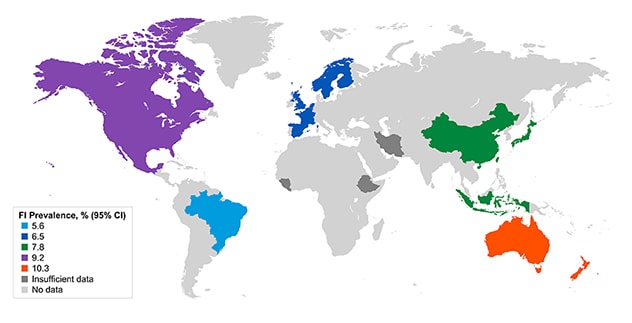Oct. 22, 2024
Fecal incontinence (FI) is the uncontrolled passage of solid or liquid stool for three months or longer. The severity of FI depends on several factors, including the frequency of FI, the type of stool passed, the amount of stool leakage, and the presence and severity of rectal urgency. This condition can significantly impair quality of life, especially for individuals who experience extreme urgency.
Common risk factors for this condition are bowel disturbances, including diarrhea, anal sphincter trauma (due to obstetric injury or previous surgery), rectal urgency and chronic illness. Other less common risks include neurological disorders, inflammatory bowel disease and pelvic floor anatomical disturbances.
Past studies have not always captured the prevalence of FI among community-dwelling adults, leaving clinicians' understanding of the global epidemiology of this condition incomplete and outdated. To address this knowledge gap, a team of researchers at the University of Tubingen in Germany, and Mayo Clinic in Rochester, Minnesota, conducted a systematic review and meta-analysis analyzing the prevalence of FI and its relationship with age, sex and geographic location in community-dwelling adults. The results of this study were published in Clinical Gastroenterology and Hepatology in 2024, with Adil E. Bharucha, M.B.B.S, M.D., a gastroenterologist and researcher at Mayo Clinic in Rochester, Minnesota, serving as the publication's corresponding author. Dr. Bharucha's research focuses on FI and other anorectal and pelvic floor disorders.
Study methods
The researchers searched multiple publication databases and identified 5,175 population-based surveys assessing the prevalence of FI or anal incontinence among teenagers and adults.
Their final analysis included information from 80 studies. The median response rate for the surveys included in the analysis was 66%, with an interquartile range (IQR) of 54% to 74%.
Results
 FI 的患病率
FI 的患病率
FI 在澳大利亚和大洋洲的发病率最高,其次是北美、亚洲和欧洲。
- Among the 548,316 individuals included in the surveys, the pooled global prevalence of FI was 8%; 95% confidence interval (CI), 6.8% to 9.2%. Using Rome criteria, the prevalence was 5.4%; 95% CI, 3.1% to 7.7%.
- FI prevalence was greater for people age 60 and older (9.3%; 95% CI, 6.6% to 12.0%), compared with younger people (4.9%; 95% CI, 2.9% to 6.9%).
- FI was more prevalent among women (9.1%; 95% CI, 7.6% to 10.6%) than men (7.4%; 95% CI, 6.0% to 8.8%).
- The prevalence of FI was highest in Australia and Oceania, followed by North America, Asia and Europe, but prevalence could not be estimated in Africa and the Middle East.
Overall, the study data demonstrated that FI is as prevalent as irritable bowel syndrome (IBS). The researchers state that the greater prevalence of FI in women may be partly explained by obstetric injury to the anal sphincters and pelvic floor, lower anal resting and squeeze pressures, and the higher prevalence of IBS in women.
Over the past two decades, Dr. Bharucha has published extensively on the prevalence of FI and its impact on women and adults. In articles published in Gastroenterology (2005) and Clinical Gastroenterology and Hepatology (2006), Dr. Bharucha and co-investigators observed that nearly 1 in 4 community-dwelling women with FI reported that their symptoms have a moderate or severe impact on their quality of life. He also has co-authored publications on FI that provide details about FI risk factors and pathophysiological mechanisms, management options and impact on quality of life. These publications appeared in Gastroenterology in 2010 and in Nature Reviews Disease Primers in 2022.
"Fecal incontinence is a common, and often distressing symptom. We have learned that many women suffer in silence, which is regrettable, because they may benefit from existing treatments," explains Dr. Bharucha. "Our findings should prompt clinicians to ask all their patients, especially older women and patients with diarrhea, whether they have FI," says Dr. Bharucha.
Dr. Bharucha says that these findings also indicate that there is a need for more research focused on FI. "We need to better understand why some persons are reluctant to share the symptoms, the factors that determine the severity of FI and the impact of FI on quality of life. In the year ahead, we anticipate hearing about new data from controlled clinical trials in FI."
For more information
Mack I, et al. Global prevalence of fecal incontinence in community-dwelling adults: A systematic review and meta-analysis. Clinical Gastroenterology and Hepatology. 2024;22:712.
Bharucha AE, et al. Prevalence and burden of fecal incontinence: A population-based study in women. Gastroenterology. 2005;129:42.
Bharucha AE, et al. Symptoms and quality of life in community women with fecal incontinence. Clinical Gastroenterology and Hepatology. 2006;4:1004.
Bharucha AE, et al. Bowel disturbances are the most important risk factors for late onset fecal incontinence: A population-based case-control study in women. Gastroenterology. 2010;139:1559.
Bharucha AE, et al. Faecal incontinence in adults. Nature Reviews Disease Primers. 2022;8:53.
Refer a patient to Mayo Clinic.